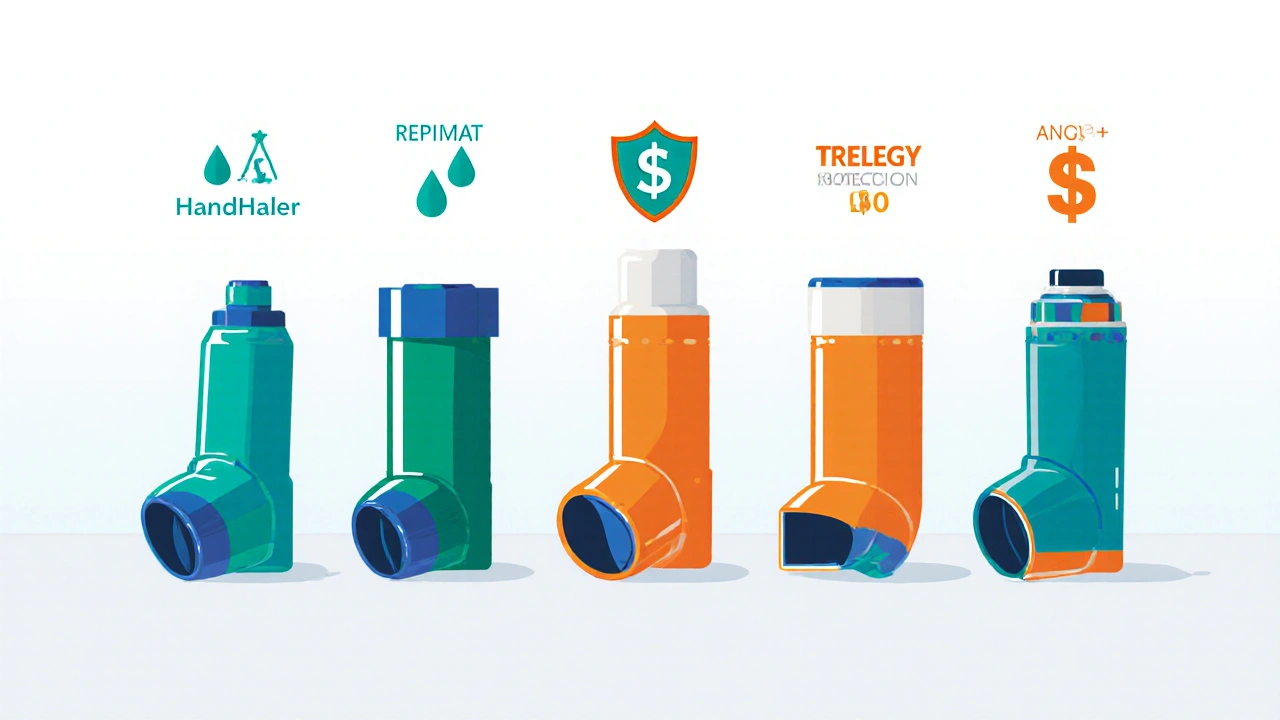Spiriva (Tiotropium) vs Alternative COPD Inhalers: A Detailed Comparison
 Oct, 26 2025
Oct, 26 2025
COPD Inhaler Decision Helper
This tool helps determine the most appropriate COPD inhaler based on your GOLD stage, exacerbation history, and other important factors. Based on information from the article comparing Spiriva (tiotropium) with alternative COPD inhalers.
Patient Information
Key Takeaways
- Spiriva (tiotropium) is a once‑daily LAMA that provides steady bronchodilation for most COPD patients.
- Combination inhalers (ICS + LABA + LAMA) often offer better symptom control for people with frequent exacerbations.
- Side‑effect profiles differ: anticholinergics can cause dry mouth, while steroids may raise infection risk.
- Cost varies widely; generic tiotropium is cheaper than brand‑name triple combos, but insurance formularies can flip the balance.
- Choosing the right inhaler means matching the drug class to the patient’s GOLD stage, exacerbation history, and inhaler technique.
When treating Chronic Obstructive Pulmonary Disease (COPD) is a progressive lung disease marked by airflow limitation, doctors rely on inhaled medications to keep airways open and reduce flare‑ups. Spiriva is a once‑daily inhaled anticholinergic (tiotropium bromide) that relaxes airway smooth muscle and improves lung function for many patients. But Spiriva isn’t the only option on the market. Below we compare it with the most common alternatives, looking at how each works, real‑world effectiveness, safety, dosing, and cost.
How Spiriva (Tiotropium) Works
Tiotropium belongs to the LAMA (long‑acting muscarinic antagonist) class. It blocks the M3 receptors that normally trigger bronchoconstriction when stimulated by acetylcholine. The blockade persists for about 24 hours, allowing once‑daily dosing.
Major Alternatives: Classes and Examples
Inhaled therapies for COPD fall into three main categories:
- LAMA - long‑acting anticholinergics (e.g., Spiriva, Anoro combines umeclidinium with a LABA).
- LABA - long‑acting beta‑agonists that relax airway smooth muscle via beta‑2 receptors (e.g., Breo Ellipta mixes a LABA with an inhaled steroid).
- ICS - inhaled corticosteroids that dampen airway inflammation (often paired with LABA or LAMA in combo inhalers).
Common brand‑name combos include:
- Advair - fluticasone (ICS) + salmeterol (LABA)
- Breo Ellipta - fluticasone (ICS) + vilanterol (LABA)
- Anoro - umeclidinium (LAMA) + vilanterol (LABA)
- Trelegy Ellipta - fluticasone (ICS) + umeclidinium (LAMA) + vilanterol (LABA)
- Combivent - ipratropium (short‑acting anticholinergic) + albuterol (short‑acting beta‑agonist)
Efficacy: What the Evidence Says
Large Phase III trials (e.g., UPLIFT for tiotropium, TRILOGY for triple therapy) provide the backbone of our knowledge.
| Medication | Study Highlight | FEV₁ Improvement (ml) | Exacerbation Reduction |
|---|---|---|---|
| Spiriva (tiotropium) | UPLIFT (2011) | ~130 | ≈15% vs placebo |
| Advair (fluticasone/salmeterol) | TORCH (2007) | ~115 | ≈12% vs placebo |
| Breo Ellipta (fluticasone/vilanterol) | KRONOS (2018) | ~130 | ≈15% vs LABA alone |
| Anoro (umeclidinium/vilanterol) | APEX (2015) | ~140 | ≈18% vs LAMA alone |
| Trelegy Ellipta (ICS/LAMA/LABA) | TRILOGY (2016) | ~170 | ≈30% vs LAMA alone |
In plain terms, all options improve lung function, but triple therapy (Trelegy) shows the biggest jump in both FEV₁ and exacerbation reduction. However, the incremental benefit comes with higher cost and more steroid‑related risk.

Safety Profile: What to Watch For
Each class carries distinct side‑effects:
- LAMA (Spiriva, Anoro): dry mouth, constipation, rare urinary retention.
- LABA (Breo, Advair): tremor, tachycardia, occasional nervousness.
- ICS (Advair, Breo, Trelegy): oral thrush, hoarseness, modest increase in pneumonia risk for severe COPD.
- Combination products: mix of the above, plus potential drug‑drug interactions if patients are on beta‑blockers.
Overall, tiotropium’s side‑effect burden is low, which is why many clinicians start with a LAMA monotherapy for GOLD stage 2-3 patients.
Dosing & Administration: Simplicity vs Flexibility
Spiriva’s once‑daily 18 µg dose via the HandiHaler or Respimat inhaler is praised for adherence. In contrast:
- Advair requires twice‑daily inhalation.
- Breo and Trelegy are once‑daily, but the device (Ellipta) can feel bulkier.
- Anoro is also once‑daily, but the combo adds a LABA that can cause mild palpitations.
- Combivent is short‑acting; patients need multiple doses per day for acute relief.
If a patient struggles with inhaler technique, the simpler the device, the better the real‑world outcome.
Cost Considerations in 2025
Price is often the deciding factor. Below is a snapshot of average monthly retail price before insurance (prices vary by pharmacy and region).
| Medication | Class | Frequency | Typical Monthly Cost | Insurance Tier (Typical) |
|---|---|---|---|---|
| Spiriva (tiotropium) | LAMA | Once daily | $280 | Tier 2 |
| Advair (fluticasone/salmeterol) | ICS + LABA | Twice daily | $310 | Tier 3 |
| Breo Ellipta | ICS + LABA | Once daily | $340 | Tier 3 |
| Anoro (umeclidinium/vilanterol) | LAMA + LABA | Once daily | $375 | Tier 3 |
| Trelegy Ellipta | ICS + LAMA + LABA | Once daily | $440 | Tier 4 |
| Combivent | SAMA + SABA | As needed | $190 | Tier 1 |
Generic tiotropium entered the market in late 2023, shaving $80‑$100 off the brand price. Still, many health plans place triple therapy on higher tiers, so out‑of‑pocket costs can exceed $500 per month.
Putting It All Together: When to Choose Spiriva vs an Alternative
Guidelines from the GOLD (Global Initiative for Chronic Obstructive Lung Disease) 2024 update recommend a stepwise approach:
- Start with a single long‑acting bronchodilator (LAMA or LABA) for most patients.
- If symptoms persist, add a second bronchodilator from the other class (LAMA + LABA).
- For frequent exacerbators (≥2 per year) or those with asthma‑COPD overlap, introduce an inhaled corticosteroid (ICS) → either an ICS/LABA combo or a triple inhaler.
In practice, Spiriva works best when a patient needs consistent bronchodilation without the added steroid burden-think GOLD stage 2‑3, low exacerbation risk, and a preference for once‑daily dosing. If a patient keeps having flare‑ups despite LAMA, stepping up to Anoro or Trelegy may be warranted.
Practical Tips for Switching or Adding Therapy
- Check inhaler technique. Even the best drug fails if the patient can’t sync breath with actuation.
- Review comorbidities. Heart disease may steer you away from high‑dose beta‑agonists; a history of oral thrush pushes you toward steroid‑sparing options like Spiriva.
- Ask about cost. Provide a cost‑comparison sheet to the patient; sometimes a generic LAMA is more affordable than a branded triple inhaler.
- Monitor response. Schedule spirometry or symptom questionnaires at 4‑6 weeks after any change.
Frequently Asked Questions
Can I use Spiriva and an inhaled steroid at the same time?
Yes. Many doctors prescribe a LAMA like Spiriva alongside a separate inhaled corticosteroid (e.g., Flovent) when the patient needs both bronchodilation and anti‑inflammatory control.
Is the Spiriva Respimat easier to use than the HandiHaler?
Most patients find the Respimat’s soft mist easier to inhale because it requires a slower, deeper breath. The HandiHaler, however, delivers a consistent dose without a propellant, which some prefer for reliability.
What’s the biggest downside of triple therapy like Trelegy?
The main concerns are higher cost and the added risk of steroid‑related side effects, especially oral thrush and a modest increase in pneumonia risk for severe COPD patients.
Do I need a prescription for Spiriva?
Yes. Tiotropium is a prescription‑only medication in the United States and most other countries.
How quickly does Spiriva start working?
Patients usually notice improved breathing within 30 minutes, with full bronchodilation achieved after 24 hours of consistent use.
Bottom line: Spiriva (tiotropium) remains a solid first‑line choice for many COPD patients because of its once‑daily simplicity and low side‑effect profile. When symptoms linger or exacerbations become frequent, stepping up to a LAMA + LABA combo or a triple inhaler can offer extra relief-but at a higher price and with more monitoring needed. Talk with your healthcare provider about your GOLD stage, exacerbation pattern, and budget to find the best match.

Jennyfer Collin
October 26, 2025 AT 14:12It is worth noting that the corporate interests behind the Spiriva brand have, historically, exerted considerable influence over the GOLD guidelines, shaping prescription patterns to favor patented LAMA products 😊. While the clinical data are robust, one must remain vigilant about potential conflicts of interest that could affect drug pricing strategies and formulary decisions. The once‑daily dosing schedule is undeniably convenient, yet the exclusivity of the delivery devices may limit patient choice.
Tim Waghorn
October 30, 2025 AT 15:26The cost breakdown presented aligns with recent Medicare Part D analyses, indicating that generic tiotropium now averages around $200‑$220 per month, whereas triple therapy escalates beyond $500 for many beneficiaries. This disparity underscores the importance of tier placement in formularies, which can obscure true out‑of‑pocket expenses for patients.
Paul Luxford
November 3, 2025 AT 16:39The summary captures the key points well.
Nic Floyd
November 7, 2025 AT 17:52From a pharmacoeconomic standpoint the LAMA monotherapy presents a favorable incremental cost‑effectiveness ratio when juxtaposed against combination regimens such as LAMA/LABA or triple therapy the marginal utility gains are offset by the escalated budget impact especially in health systems constrained by capitated payments the physiologic rationale for LAMA‑driven bronchodilation rests on sustained muscarinic antagonism which translates to a consistent FEV1 uplift across circadian cycles however the real‑world adherence data reveal a decay curve beyond the initial 90‑day window largely attributable to device complexity and patient dexterity considerations the HandiHaler, while robust, demands a coordinated inspiratory effort that many geriatric patients struggle to achieve consequently the Respimat soft‑mist aerosol offers a lower inspiratory flow threshold and may improve deposition in peripheral airways albeit at a modest price premium additionally the safety profile of tiotropium, characterized by a low incidence of systemic anticholinergic effects, renders it a suitable candidate for patients with comorbid cardiovascular disease the risk of urinary retention remains negligible in the absence of pre‑existing prostatic hyperplasia yet clinicians should remain observant for xerostomia which, if severe, can exacerbate oral hygiene issues and predispose to dental caries the comparative meta‑analysis of UPLIFT versus TRILOGY trials demonstrates a statistically significant, albeit clinically modest, advantage of triple therapy in reducing exacerbation frequency the number needed to treat approximates 15 to prevent one severe exacerbation per year a figure that must be weighed against the heightened pneumonia risk associated with inhaled corticosteroids especially in GOLD stage 4 patients the therapeutic algorithm thus advocates an initial LAMA step, escalation to LAMA/LABA for persistent symptoms, and reserved use of triple therapy for high‑risk exacerbators the economic modeling suggests that, under a willingness‑to‑pay threshold of $50,000 per quality‑adjusted life year, LAMA monotherapy remains cost‑effective across most payer landscapes 😊
Johnae Council
November 11, 2025 AT 19:06Honestly, the article sounds like a glorified sales brochure. It throws around FEV1 numbers like confetti but forgets to mention how many patients actually struggle with the fiddly inhalers. Plus, those cost tables are from a single retailer – not exactly a nationwide analysis.
Manoj Kumar
November 15, 2025 AT 20:19Well, if you’ve got a PhD in cynicism, you’ll see the hidden agenda in every chart. Meanwhile, the rest of us just want a breath that doesn’t feel like we’re inhaling a vacuum. Sure, the price tags are scary, but at least you’re not stuck choking on steroids.
Hershel Lilly
November 19, 2025 AT 21:32It’s crucial to assess inhaler technique before attributing suboptimal response to the medication itself. Many patients misuse the HandiHaler by not achieving the required inspiratory flow, resulting in under‑dosing. A brief training session with a respiratory therapist can markedly improve drug delivery and clinical outcomes.
Kasey Marshall
November 23, 2025 AT 22:46Interesting take on the cost side – I’ve seen patients switch to generic tiotropium and actually stick with it better than the fancier combos.
Laura Hibbard
November 27, 2025 AT 23:59Yeah, because nothing says “I care about my breathing” like juggling a weird device and a giant pharmacy bill 🙃.
Rachel Zack
December 2, 2025 AT 01:12People shouldnt ignore thier own experience with meds.
Lori Brown
December 6, 2025 AT 02:26Exactly! Your voice matters, and finding the right inhaler can be a game‑changer 🌟. Keep advocating for what works best for you.